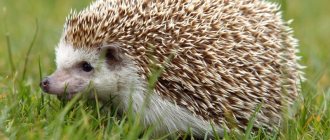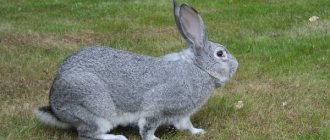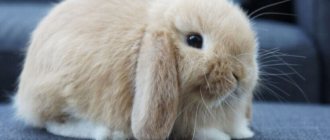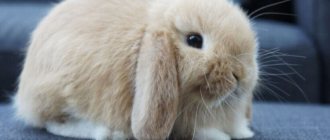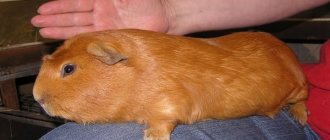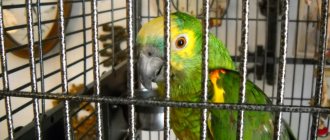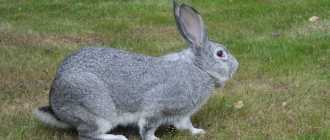Among decorative rabbits, the colored dwarf is one of the most common breeds. For example, at the 2000 exhibition in Austria, almost three hundred of these babies were presented. And it wasn’t just their cute appearance that brought them great popularity. This animal is ideal for small apartments, requires minimal care, and has an easy-going disposition. But, nevertheless, before buying such a baby, you should familiarize yourself in detail with the characteristics of this breed and the nuances of keeping the animal.
Description of the Colored Dwarf breed
This short-haired dwarf rabbit will be loved not only by children, but also by adult family members. A little miracle called a colored dwarf comes in a wide variety of colors.
Here is a list of some of them:
- Siamese;
- blue;
- chinchilla;
- black;
- grey;
- fiery;
- squirrel;
- hotot;
- Havana;
- Japanese;
- Russian;
- Dutch;
- "ren";
- Thuringian;
- white-awned;
- silver;
- luxury;
- red.
One of the most popular colors among fans is oto. This is a white rabbit with a beautiful black spot around the eyes. The spot must be of the correct shape.
Short-haired dwarf rabbit - a friend in taste and color
It is not always possible to have a dog or a cat, but you really want to have a soft and warm creature nearby.
In this case, the rabbit is perhaps ideal.
A cozy and flexible animal will bring a lot of pleasure. Moreover, caring for it is simple and the costs are low.
These animals are small in size, they do not need a bulky cage, you can afford to have them in any, even small apartment.
Any long-eared rabbit can be a family pet, but there are specially bred dwarf rabbits adapted for home keeping.
There are several breeds of such babies, and among them is a tiny miracle - a short-haired colored dwarf rabbit .
Origin of the breed
The animals appeared in 1938 by crossing a Hermelin and an outbred rabbit by the German rabbit breeder Hoffmann. In 1957, there were more than 20 coat colors of this breed.
There are two main versions. The first says that it was bred in Holland, and a wild rabbit and red-eyed representatives of the Polish breed were taken as the starting material for it. This happened between 1920 and 1930.
The second theory says that all the credit for breeding colored decorative rabbits belongs to the German breeder Hoffmann. It is believed that he bred the first representatives of the breed line in 1938 by crossing the Hermelina with an animal without a clear breed affiliation.
Minilop
And finally, one of the most difficult dwarf species to breed.
The story with the dwarf genes and splitting in this breed is very complicated, we will dwell on it another time in more detail.
It must be said that the ideal weight for a minilop is 1-1.3 kg, when it grows up to 1.6 kg.
The rabbit's body is massive, but compact, the back is round, the neck is not visible.
The head in profile resembles a ball, the eyes are deep-set, the ears droop, which is why the rabbit has a sad expression on its face.
The breed was developed in the Netherlands and is distributed mainly in Europe.
Here you can buy a minilop rabbit for 2000 rubles, an elite one - over 5000 rubles.
The optimal price is 2500-3000 rubles.
Remember that damn important thing at the beginning of the article? So here it is. You really should understand the breeds of not “decorative” rabbits, but dwarf rabbits
Otherwise, you risk buying a mini-pet from an unscrupulous breeder and ending up with some kind of meat giant.
Standard
The name “colored dwarf” speaks for itself: The maximum permissible figure is 1.5 kg.
The European document prescribes the desired weight in the range of 1.1-1.25 kg. The minimum value cannot fall below 0.8 kg.
The body of rabbits of the Colored Dwarf breed is stocky and cylindrical in shape. The front legs are short. The tail is small, tightly fitting to the body. Females do not have dewlaps. The head is large and short. The coat has a good shine. The ears of such pets are raised straight up.
How to toilet train an animal
Accustoming a baby rabbit to a litter tray requires a lot of patience from the owner.
The little rabbit is gradually getting used to the toilet, but you will have to be a little patient. It is advisable to remember in which corner the breeder had the tray and place it there at home. It is worth asking the breeder for some used litter and mixing it with the old one. The pet will quickly find its native smell.
If the baby doesn't get into the tray, there's no need to swear. As soon as it becomes noticeable that your pet wants to go to the toilet, you must immediately put him in the litter tray. After a job done successfully, the animal should be praised. If you patiently train your pet to use the toilet day after day, the result will be achieved.
Character traits
The character of this rodent directly depends on how it is treated. If the animal is not scared, loved, often picked up and caressed, then it will respond in kind. When a rabbit is having a good life, why would it be aggressive?
Important! You should especially carefully monitor such living creatures during the period close to puberty. At this time, animals often behave restlessly and even aggressively. Such aggression can manifest itself both towards other eared animals and towards humans. The pet achieves complete calm only by the age of 1.5 years.
Dwarf rabbits are attractive not only by their appearance, but also by their friendliness. Fluffies get used to their owners in record time and quickly remember their own name. You simply don’t want to keep such a cute little animal in a cage continuously, so many owners prefer to let their pet walk around the house for a long time. The toilet problem is easily solved - it is no more difficult to train a colored miniature rabbit to use a litter tray than a kitten.
Behavioral characteristics
Thanks to targeted breeding for home keeping and close contact with humans, animals have a calm and docile character. During the selection process, aggressive individuals were discarded.
If you interact and play with your pet every day, and tame it gently and patiently, the colored rabbit will quickly become tame and learn to perform simple funny tricks.
The owner needs to remember that the rodent is curious and shy. If frightened, your pet may bite or scratch with its hind legs. The animal must be protected from stress.
Conditions of detention
Rabbits, as animals with a well-developed nervous system, are susceptible to stress. It arises as a result of sharply changing external conditions. Such changing conditions are: a transition from one diet to another, a sharp change in daily routine, a prolonged absence of water or food, human control of nests when the cubs are there, a bright flash of light in the dark, catching rabbits in an enclosure and other sudden influences that cause stress.
An unsatisfactory microclimate in the room where rabbits are kept also contributes to the development of stress. Lack of sufficient ventilation leads to the accumulation of harmful gases and dust in the air, which is also one of these causes of stress, and can result in respiratory paralysis and death of the animal.
Requirements for the cage - its dimensions must be 5 times larger than the dimensions of the rabbit. If several animals are kept in one enclosure, then 6-7 per individual. The rods are metal, without varnish or paint. The house is located in a place protected from direct sunlight and drafts. There should be bedding on the floor of the cage. This can be sawdust, straw, or special granules that absorb moisture.
Colored rabbits do not tolerate heat above +25C and easily catch colds in frosts below -18C. In open sun, the enclosure or cage should be shaded and cooled with cold water bottles or ice packs wrapped in a cotton towel.
In cases where the animal has freedom of movement around the house, it is necessary to hide all wooden products, wires, documents from it, and cover the furniture legs with something. Rabbits are constantly growing teeth, and in an attempt to wear them down, they will chew on anything they can get their hands on. But if desired, the baby can be weaned from this.
Rabbit in an enclosure
The enclosure is installed in a corner where enough light comes in, but not under the window itself. Direct sunlight is harmful to the rabbit. They enclose it with a net, and be sure to attach a door to let the pet out for a walk. The floor is covered with a rug; dwarf rabbits are not allowed to sit on plastic or laminate.
The smallest dwarf rabbit from the USA, registered in the Guinness Book of Records, weighed only 400 g. Although a female weighing 297 g now lives in Chelyabinsk and her owners have applied for the record.
The rabbit's enclosure should not be in a place that is too dry or windy.
Breeding
Animals become sexually mature at the age of 12 weeks, but they cannot be bred earlier than 6 months. The female comes into heat every 20 days, becoming restless and irritable. She is placed in a cage with a male, who carries out the cage.
A rabbit's pregnancy lasts 28–35 days. A week before the expected birth, the females place a nest house in the cage and provide it with hay. The female rabbit herself drags the hay into the house and plucks some fluff to cover her offspring.
From 3 to 7 cubs are born - naked, blind and deaf. The female feeds them with milk for up to 2 months. Already at 18–20 days, the babies open their eyes and begin to leave the nest in search of additional sources of food. From this time on, feed must be supplied 2–3 times more, taking into account its consumption by young animals.
Keeping decorative colored rabbits at home is an easy and fun activity. Communication with a curious and intelligent animal brings joy and helps you relax.
Feeding
This little one is very modest in nutrition. The basis of the diet is hay, ready-made grain mixtures and drinking water. Fresh vegetables and fruits are used as top dressing - carrots, apples, cabbage, beets, lettuce and fresh herbs.
Rabbits must be given clean, settled and filtered water at a temperature of +15...+18 degrees. It is poured into dropper drinking bowls - plastic bottles with a metal spout.
For dwarf rabbits, pet stores offer many types of different mixtures and granular feeds. The advantage of this option is that the daily norms of microelements and nutrients have already been calculated. It is enough to give food according to the dosage from the package and do not forget about water. In addition, industrial mixtures are enriched with minerals and vitamins. You don't need to buy them separately.
Diseases
The disease can occur due to poor nutrition. Namely, the diet of rabbits should not include:
- chocolate;
- cookies;
- food from your table;
- potato;
- drops and “honey sticks”;
- bread and flour products.
Vintage basket
Here we are dealing with a representative design in the style of modern rural fashion. Best suited for lovers of cycling or short distance travel on scooters. The basket itself is woven from flexible willow and equipped with an openwork wire lid, which prevents the cat from wanting to get out while moving. At the first glance at such a carrier, one is reminded of idyllic pictures from centuries ago, when food from the market was transported in a similar way on bicycles. The entire structure is conveniently attached to the steering wheel using leather straps and does not require much time for preparation.
The advantage of the option under consideration is, of course, its original design and originality. The downside is limited functionality. Although, if desired, the basket can be used for its intended purpose.
Price – 1,128 – 1,708 rubles.
Care
In general, colored miniature fluffies have strong natural immunity. To keep your pet healthy, it is enough to get all the necessary vaccines against pasteurellosis, hemorrhagic disease and myxomatosis. and control the quality of his diet.
Be sure to include mineral supplements in your diet. Calcium is very important for rabbits. When it is deficient, dangerous symptoms such as convulsions, heart failure appear, and small rabbits can even die from this.
You should especially carefully monitor such living creatures during the period close to puberty. At this time, animals often behave restlessly and even aggressively. Such aggression can manifest itself both towards other eared animals and towards humans. The pet achieves complete calm only by the age of 1.5 years.
Lifespan
Representatives of dwarf breeds live mainly 5-7 years. If you take good care of them, this period can reach 10-12 years. Important:
- do not create stressful situations;
- you cannot shout or make sudden movements that may scare the rabbit;
- when traveling, use a special bag;
- carry out vaccinations;
- high-quality nutritious food.
When purchasing, you should pay attention to affectionate breeds so that the animal quickly gets used to humans. The child must understand that one should not hurt living beings, that one must treat them with care.
Purchase
Buying colored dwarf rabbits has some difficulties. For example, they are very easy to confuse with baby rabbits of larger breeds. If you give in to your emotions and buy a representative of the dwarf line from the first seller you come across, in a couple of months you will receive an animal of impressive size. To avoid this, you should choose a seller of purebred dwarf rabbits very carefully.
Therefore, it is better to purchase this pet in specialized nurseries or from private breeders, at fairs and through advertisements. For example:
- Krol Arthur - St. Petersburg;
- Les lapins MarSi – Moscow.
The price depends on color, nursery and other factors. You should buy a baby no earlier than one month of age. Such a little rabbit will weigh only about 200 grams; as it grows, it will not only grow larger, but will also change a little - its muzzle will elongate a little, its forehead will become wider, its ears will be longer.
When choosing a purchase, follow these rules:
- It is advisable to make a purchase in specialized nurseries, and not in regular pet stores.
- The rabbit must be active, constantly on the move. The coat and eyes are shiny.
- You should carefully examine the eyes, nose, and anus for any discharge. If they are present, the animal is unhealthy.
- It is definitely worth checking the condition of the animal’s skin. To do this, pick him up and gently run your finger against the pet’s fur, looking for places of damage and the presence of parasites.
- To determine the character of the animal and whether it is accustomed to being handled, you can pick it up and hold it for a while, constantly stroking it. Calm individuals will not break out.
How many years do decorative rabbits live?
The average lifespan of domestic rodents is 8-10 years. Dwarf rabbits live a little less - 7-8 years. Much depends on the conditions in which the animal is kept. With good care, long-eared pets rarely die before the allotted time.
The lifespan of an animal is influenced by the following factors:
- Lifestyle. The rabbit needs to move a lot. Physical activity will help speed up your metabolism and avoid weight gain.
- Diet. Rabbits have a sensitive digestive system, so it is important to monitor your pet's diet.
- Conditions of detention. The rodent must be protected from hypothermia, overheating, temperature changes, and dampness, otherwise it may get sick and die.
- Castration. Veterinarians say that spayed and neutered rabbits live on average 1-2 years longer.
A caring owner can prolong the life of his pet. What is needed for this:
- keep the animal in a spacious cage;
- feed correctly, do not give prohibited foods;
- Vaccinate your rabbit in a timely manner;
- monitor the cleanliness of the rodent’s body and home;
- protect him from stressful situations.
The approach of old age is indicated by changes in the behavior of the decorative rabbit. Over time, his activity decreases, he ceases to be interested in games. In older animals, their fur thins, their eyes become cloudy, and their muscles weaken. But we must remember that in old age a pet needs the love and care of its owner even more.
Colored dwarf - owner reviews
Anastasia B. I wouldn’t have gotten a rabbit myself, I wouldn’t have even thought about it, but my brother gave me this little miracle. At first I was afraid that they wouldn’t get along with the cat, but to my surprise they have been living together for three months now. It's easy to feed a rabbit - hay, food, carrots, apples, he loves everything. She even loves cabbage, but I read that it’s better not to give it.
Irina M. They gave me a rabbit for Christmas. Very active, but a coward - afraid of strangers. There were no problems with litter box training; the principle is similar to training cats or dogs.
What are the pros and cons?
Among the advantages of this breed are the following:
- no need to wash regularly;
- good-natured character;
- easy to train to the tray;
- not picky about food.
Due to their character traits, such rabbits require constant attention. Animals are prone to mood swings. Like other rabbits, this variety sheds every three months. In addition, animals need a spacious enclosure.
See also
Composition of Diclacox Forte, dosage and instructions for use for rabbitsRead
How to determine gender
In order to determine the sex of an ornamental animal, you must adhere to the following action plan:
- With your right hand, grab the rabbit by the skin between its back and head. Lift him slightly and sit him on his hind legs.
- Place it on its tail very quickly so that the animal does not have time to roll over.
- After performing these manipulations, your rabbit should lie on its back with its paws raised.
- Lift the rabbit again by the withers, and with your left hand stretch the fur in the area where the genitals are concentrated. Using two fingers, press on the genital organ as if you want to squeeze something out. If you see a small pink triangle, then it's a girl. When a pink penis is formed that looks like a trimmed pencil, it can be said that it is a boy.
You can find out how many years rabbits live by reading the article.
The video tells how long dwarf rabbits live:



